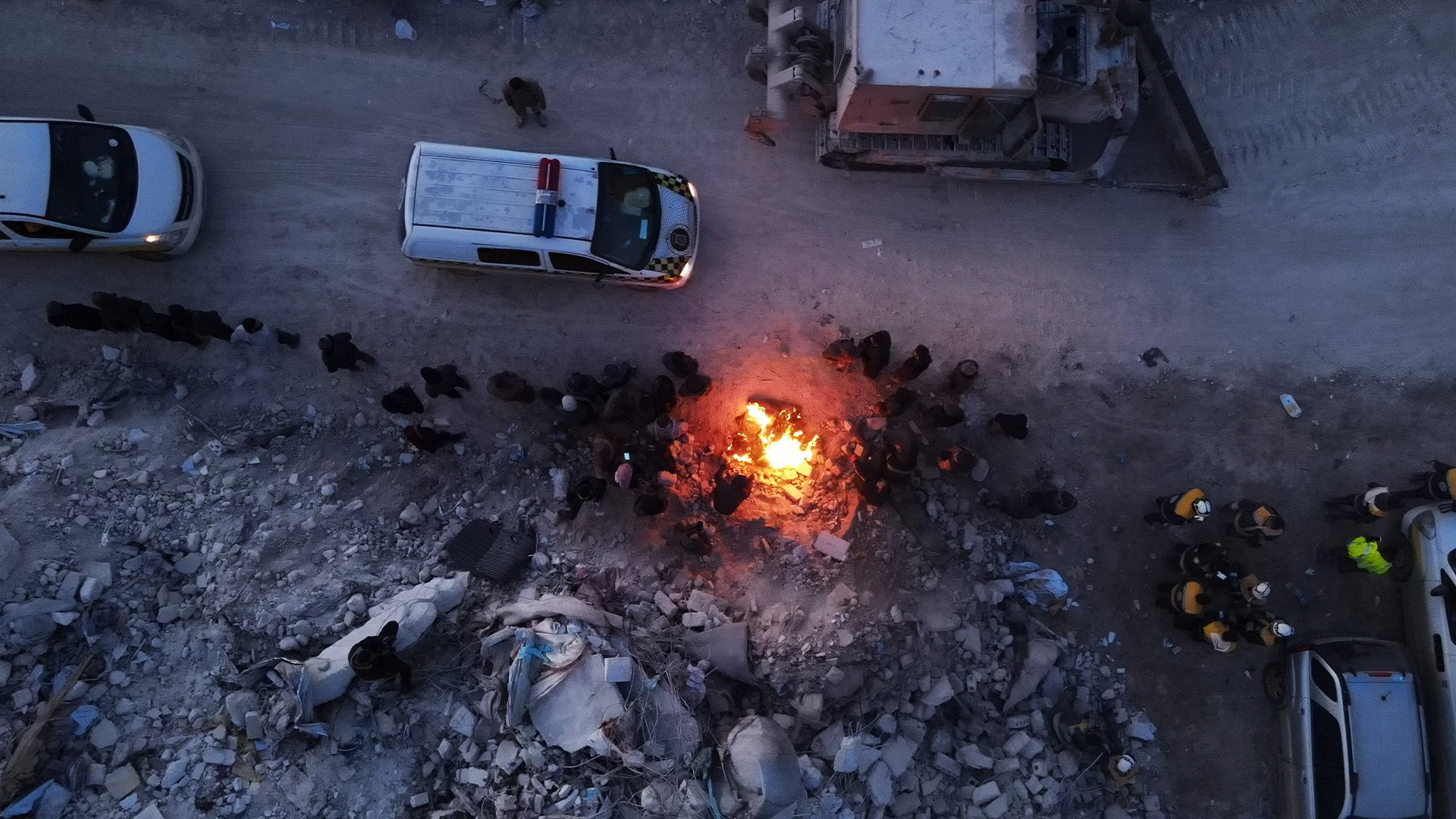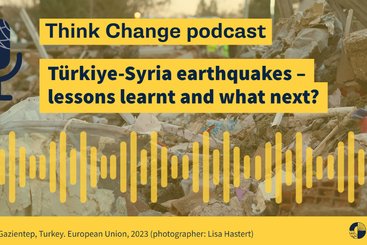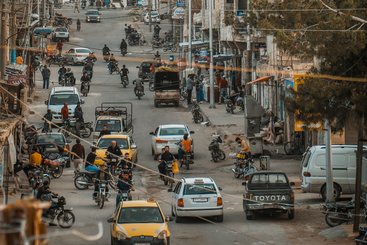‘A crisis within a crisis’ is how many described the devastating earthquakes that struck northwest Syria and southern Türkiye in the early hours of 6 February. As the impact of the earthquakes comes into focus, it is less clear what the international response to the most affected areas will look like once the emergency relief phase concludes.
In Syria, the earthquakes primarily affected the opposition-held northwest, which was already experiencing a severe humanitarian crisis impacting nearly 5 million people, more than half of whom are internally displaced people, relying heavily on life-saving humanitarian assistance, and residing in an isolated region effectively levelled by the successive waves of Russian- and Syrian-led aerial bombardments from 2019. Conditions have been worsening nationwide for months, with the secondary effects of Syria’s conflict colliding particularly heavily with insecurity in eastern Europe. Just over a week before the earthquake struck, the World Food Programme announced that food insecurity had reached its most severe levels since the beginning of Syria’s now 12-year conflict, and warned that the situation may worsen to such an extent that it further contributes to what remains the world’s largest refugee crisis.
Syria, however, has largely fallen off the radar in light of other devastating events in the world, including the conflict in Ukraine, floods in Pakistan and droughts in East Africa, to name a few. Funding for the humanitarian response in the northwest has plummeted in the past year despite needs rising to the highest levels since the start of the conflict. Political solutions to the ongoing conflict have effectively frozen given the absence of any meaningful engagement from international stakeholders – prior to the earthquakes, Syria had been heavily deprioritised. The view in most Western circles was that it’s a conflict that is better contained than resolved because its resolution is too costly. International aid access has diminished to the point that it is now constrained to a single legal border crossing – Bab el-Hawa – and dubiously impartial cross-line convoys administered by UN agencies from government-held Damascus.
Syrian regime continues to politicise aid
Syria’s President Bashar Al-Assad has long viewed cross-border aid operations into the opposition-held northwest as a transgression of Syria’s sovereignty. With ongoing support from Russia at the UN Security Council (UNSC), he has pressed ever harder to centralise international resources in Damascus, unpicking the legal frameworks that support cross-border options in an effort to channel a greater proportion of aid cross-line, affirm the legitimacy of the state, and undermine his cross-border rivals in the Syrian opposition. Additionally, the regime has been known to leverage aid to support its politico-military objectives since the earliest days of the conflict. It was therefore unsurprising that it took Assad more than a week to approve the opening of two additional border crossings with Türkiye to help facilitate the earthquake relief in the northwest.
However, reports from northeast Syria indicated that the government already blocked cross-line convoys to people impacted by the earthquake in government-held Aleppo city and demanded that half the aid in the convoys, including an ambulance, be handed over to government officials. Similar reports revealed that fuel shipments from Kurdish-controlled areas were held by government officials at checkpoints and were only released after the latter seized almost half the trucks. Additionally, the recent blocking of a cross-line aid convoy by rebel group Hay'at Tahrir Al-Sham is further evidence that political considerations take precedence over the humanitarian imperative. Despite the gravity of the situation, there is a refusal to act, indicating that the situation is unlikely to significantly improve even in the face of such immense needs.
As the earthquake has painfully illustrated, the legal and political frameworks that surround cross-border aid delivery are effectively inadequate. The first responders' calls for life-saving equipment went unanswered in the first week of the response due to the extensive litigation at the UNSC, leading to tragic consequences, including entirely avoidable loss of life. The intersection of global and Syrian geopolitics has resulted in a limited response that is unable to meet growing acute needs, let alone transition to the recovery and resilience-building phase. Reopening additional border crossings will undoubtedly facilitate the earthquake emergency response plan, so too will post-earthquake sanction exemptions issued by donor governments, and the declaration of dedicated ‘disaster zones’ by the Syrian government. However, recent experiences suggest that these measures will not be anything other than temporary. Indeed, the UN released a Syria Flash Appeal a week after the earthquake, which will only last until May.
Humanitarian access must be maintained beyond earthquake relief
The issue with these temporary measures is that most of them are solely devoted to the earthquake response, yet threats of non-renewal of cross-border mechanisms, failure to respond appropriately and in a timely fashion, and a lack of resilience and recovery work will persist long after the earthquake. The northwest is an area of compounding vulnerabilities, and its pre- and post-earthquake needs are not mutually exclusive. Türkiye, which has also been badly struck by the earthquakes, will now be more reluctant to offer support to areas under its nominal control in Syria, namely regions in the badly affected northwest. As such, the question of who will implement post-earthquake recovery and reconstruction in a region with no uniform authority rises to prominence again. As it currently stands, the patchwork of politico-military control over the northwest region has resulted in a lack of a central unified authority that is responsible for providing essential services. This has created a situation in which humanitarian organisations have become the primary providers of these services. What this means for post-earthquake recovery is that reconstruction and rehabilitation efforts in the northwest will be led primarily, if not solely, by humanitarian agencies rather than a governance authority. Not to mention, previous Syrian regime treatment of opposition-held areas around the country, for example the ‘starve or surrender’ strategy, only serves to emphasise the unlikelihood of any Damascus-led recovery efforts targeting opposition-held northwest.
As such, maintaining sustained and unrestricted humanitarian access to regions in the opposition-held northwest is imperative to the recovery of a region that relies heavily on humanitarian assistance and has been battered by over a decade of violent conflict. Reports emerged on 1 March that the UN plans to set up two new offices in opposition-held parts of Idlib and Aleppo governorates. While the terms are yet to be released, it seems unlikely that the UN has gone ahead without the approval of the Assad government. Indeed, the UN has frequently acquiesced to the demands of the state in order to retain access and assent to UN-led political initiatives (and is required to do so under the UN Charter). Meanwhile, reports emerged that the EU invited the head of the Syrian Arab Red Crescent and regime crony, Khaled Hboubati, to participate in the donors' conference to raise funds for earthquake recovery. These developments are likely to give the Syrian government an even stronger case for centralisation of aid under its control and the normalisation of government-orchestrated aid and management of a region with significantly compounding vulnerabilities.
With the 12-year anniversary of the Syrian conflict nearing and in light of the massive and rising humanitarian needs in Syria, the international humanitarian community must remain mindful of the risks of further politicising the aid effort. Delivering aid requiring authorisation of the Syrian government could lead to the co-option of assistance by the Assad government. Consideration should be given to the long-term consequences of making compromises for short-term access gains to deliver assistance. Ultimately, the international humanitarian community must ensure that aid continues to uphold humanitarian principles and reach the most vulnerable. After over a decade of conflict overlayed with the consequences of this devastating earthquake, it’s the minimum the international community can do to support Syrian people.




